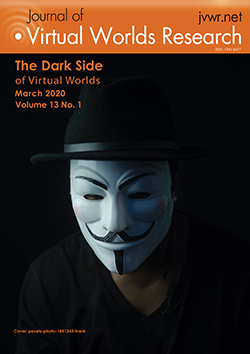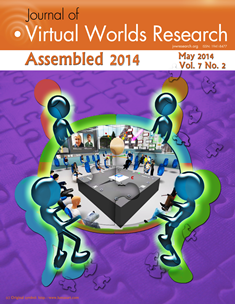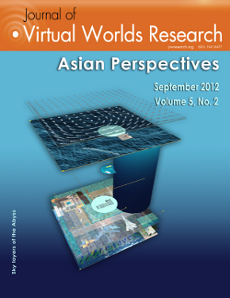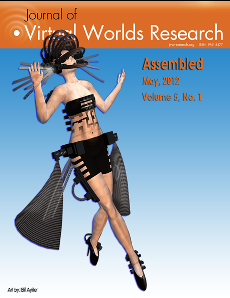Archives
-
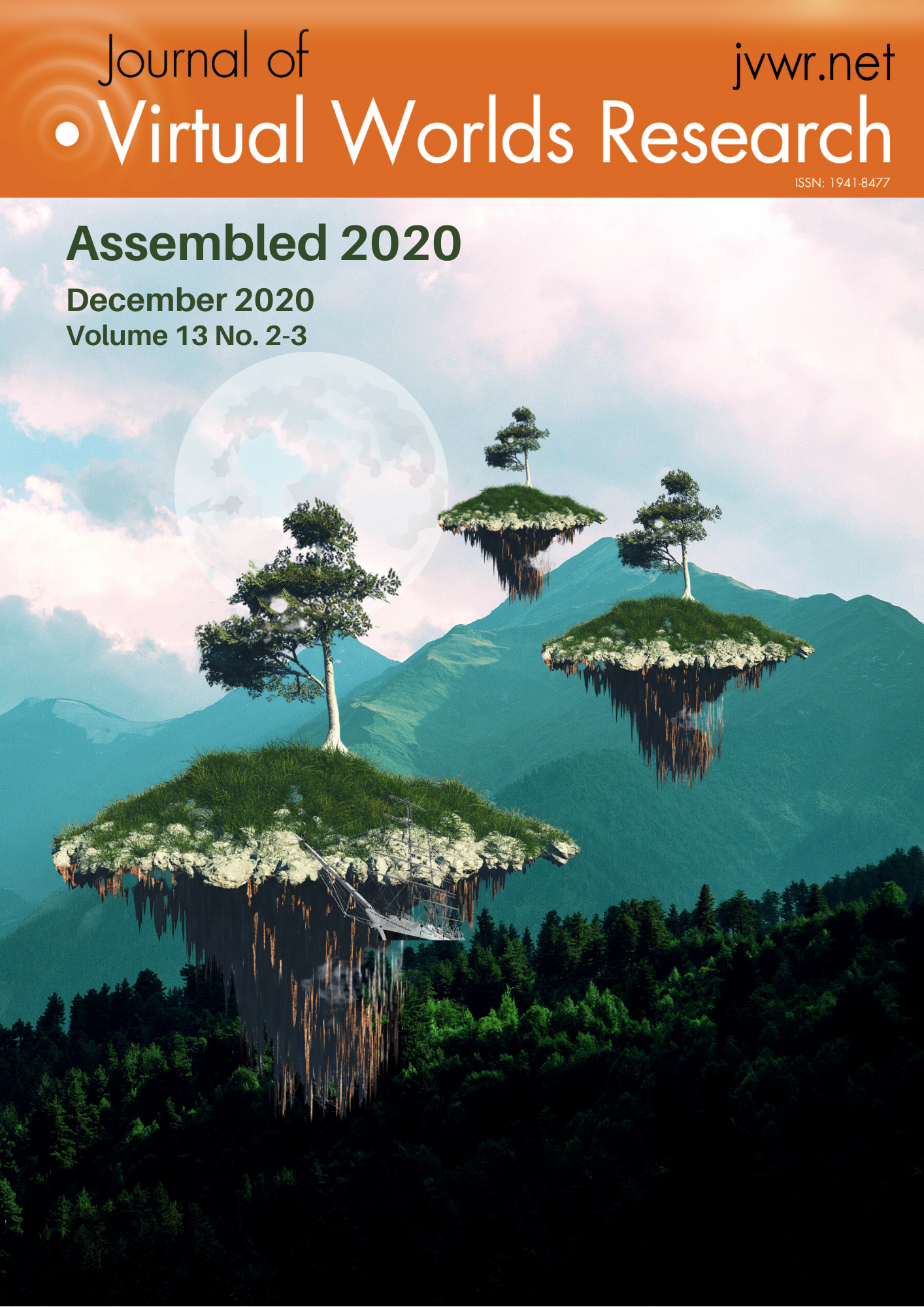
Assembled 2020
Vol. 13 No. 2-3 (2020)JVWR Assembled 2020 presents our final contribution to a focused effort within the capacity of Virtual Worlds. This issue includes three articles covering 360 audio technologies, instructional use, and the topic of purchase intentions in Virtual Worlds. The editorial team is a perfect match of diverse perspectives and experience and, when combined, construct a splendid read for academia and practitioners.
-

Assembled 2019
Vol. 12 No. 3 (2019)The Journal of Virtual World Research Assembled 2019 issue, presents six striking studies that spread over a plethora of subjects, all aimed to expand the Virtual World knowledge bank for the benefit of practitioners and academics alike. These studies broaden the understanding of a Virtual World user
-
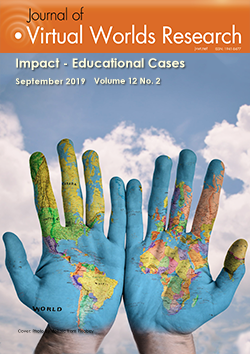
Impact - Educational Cases
Vol. 12 No. 2 (2019)In the context of educational research, definitions of
-

Pedagogy - Taking Stock and Looking Forward (Part 2)
Vol. 12 No. 1 (2019)2019 marks the tenth anniversary of a landmark issue of the Journal of Virtual Worlds Research, which was themed on
-

Pedagogy - Taking Stock and Looking Forward (Part 1)
Vol. 11 No. 3 (2018)2019 marks the tenth anniversary of a landmark issue of the Journal of Virtual Worlds Research, which was themed on
-
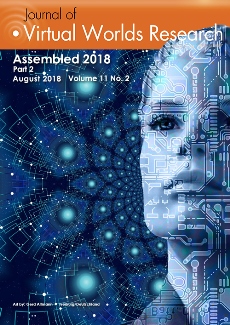
Assembled 2018 Part 2
Vol. 11 No. 2 (2018)The second part of Assembled 2018 includes five studies demonstrating rigor over a vast variety of themes tethered to Virtual World use. Studying VR/AR technologies use & development, examining online storytelling forum threads in WoW, analyzing Africans
-

Assembled 2018
Vol. 11 No. 1 (2018)This issue includes five exciting research studies covering a broad and diverse array of topic areas but still focuses on the enhancement of knowledge in the realm of Virtual Worlds. In essence, the name of the issue -

EVE Online
Vol. 10 No. 3 (2017)This special issue in the Journal of Virtual Worlds Research highlights the ways that EVE scholarship has matured. A sub-discipline within a sub-discipline, writing about EVE no longer focuses just on what makes this particular MMOG so different to the more mainstream online games and virtual worlds, but now describes in fascinating depth the elements of this virtual world that have taken 15 years of play to develop. As guest editors, we are excited to share this collection as these five articles exemplify the contributions that EVE Online scholarship will continue to make long into the future. -

Real Virtual Relationships
Vol. 10 No. 2 (2017)We live in an era of digitally-mediated relationships. From finding a spouse online to daily interactions facilitated through social media, many people build and sustain both platonic and romantic relationships with technology. Virtual worlds are also spaces for these interactions. This special issue is dedicated to an exploration of such topics in a collection of articles exploring -
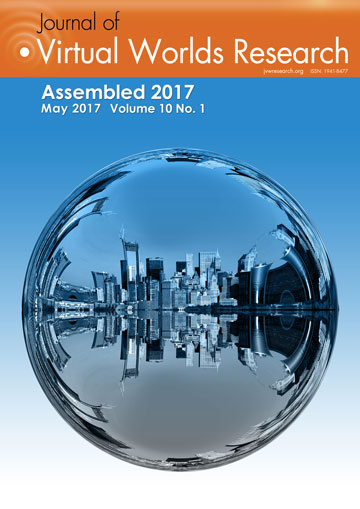
Assembled 2017
Vol. 10 No. 1 (2017)The 2017 Assembled issue of the Journal of Virtual Worlds Research is a collection of four interdisciplinary research papers, representing the diversity that is 'virtual worlds'.
They represent a field that truly is 'assembled' - emerging from and supported by passionate scholars from various intellectual backgrounds. -

Edge
Vol. 9 No. 3 (2016)Edge tech, usage and developments in Virtual Worlds. A collection of 5 papers which suggest new angles and unique points of view, is presented in this Edge issue. Each of these five papers pushes the boundaries of the disciplines in a different way. Together, they demonstrate the dual value of the JVWR, first as a stage to explore the future of virtual worlds (defined broadly,) and then help to shape the future of real worlds. -

Assembled 2016 Part 2
Vol. 9 No. 2 (2016)This issue, as with all JVWR assembled issues, aimed at highlighting the diversity of issues of virtual and real worlds.
-

Assembled 2016 Part 1
Vol. 9 No. 1 (2016)This 2016 Assembled issue of the Journal of Virtual Worlds Research relates to an eclectic group of six articles covering a variety of aspects of the use of virtual worlds. Firstly presented is a short history of the virtual world economy that provides the reader with an overview of where the virtual economy began in three virtual worlds and where it is today. The second article discusses the use of non-player characters in courses and how students reacted to these. The third article relates to the use of a virtual world to provide training for office-based medical emergencies. The fourth article explores the relationship between the real and the virtual supermarkets. The fifth article looks at lighting controls used in virtual environments, and the final article is an overview of the use of cloud in connecting video games. -

Futures
Vol. 8 No. 2 (2015)This issue presents six papers each reflecting on one angle to the future of virtual worlds: Four concrete views relating to: bots, head mounted displays (HMD), neuroscience and meditation, and eSports; as well as two theoretical views relating to the focus of virtual worlds research, and looking at virtual worlds as a mediator between -
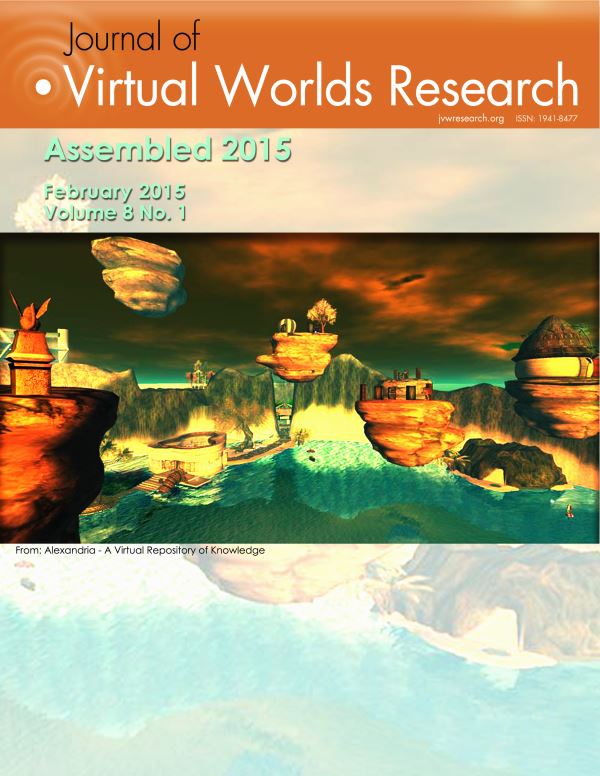
Assembled 2015
Vol. 8 No. 1 (2015)Issue editors: Stephanie Blackmon, University of Oklahoma, Norman, OK, USA, and Patricia Anderson, East Carolina University, Greenville, NC, USA
Virtual worlds hold a tremendous amount of potential for research, education, and interaction. While the literature available on virtual worlds has increased over the years, there are still unexplored arenas as well as areas that require further conversation and investigation. Some of us are continuing to develop our avatars and hone our skills in virtual worlds, while
-

Lantern - Part 2
Vol. 7 No. 3 (2014)Issue editors: Yesha Sivan, Metaverse-Labs Ltd, Tel Aviv-Yaffo Academic College, Israel; Maged Kamel Boulos, University of Plymouth, Devon, UK; David Gefen, Drexel University, Philadelphia, PA, USA; Abhishek Kathuria, The University of Hong Kong
In this issue, we take a review lantern and shed some light on some of this field -

Lantern - Part 1
Vol. 7 No. 1 (2014)Issue editors: Yesha Sivan, Metaverse-Labs Ltd, Tel Aviv-Yaffo Academic College, Israel; Maged Kamel Boulos, University of Plymouth, Devon, UK; David Gefen, Drexel University, Philadelphia, PA, USA; Abhishek Kathuria, The University of Hong Kong
In this issue, we take a review lantern and shed some light on some of this field -

Legal and Governance Challenges
Vol. 6 No. 3 (2013)Issue Editors: Melissa de Zwart, University of Adelaide, Australia; Dan Hunter, QUT Law School, Australia; Greg Lastowka, Rutgers University, USA
What is the proper relationship between the physical and virtual worlds? When should we pierce the magic circle? What is virtual property and how should we treat it? Do avatars have rights, and if so, what ones? And so on.
We have been lucky to assemble six fascinating accounts of how we might approach the laws of the virtual worlds. They are each very different, but they all expand our understanding of the intersection between legal systems and these new (game) world systems. They are worthy markers of the ten year anniversary of the field of law and virtual worlds. -

Arts
Vol. 6 No. 2 (2013)Issue editors: Celeste Lovette Guichard, Savannah College of Art and Design; Laura Salciuviene, Lancaster University Management School, UK; Gary Hardee, University of Texas at Dallas, TX, USA.
An important single thread runs through this issue: the exploration of artistic
-

The Metaverse Assembled (2013)
Vol. 6 No. 1 (2013)Issue editors: Leonel Morgado, INESC TEC (formerly INESC Porto), UTAD
-

Managerial and Commercial Applications
Vol. 5 No. 3 (2012)Issue editors: Shu Schiller, Wright State University, USA; Brian Mennecke, Iowa State University, USA; Fiona Fui-Hoon Nah, Missouri University of Science and Technology, USA.
The intriguing potential of virtual worlds has attracted a significant amount of scholarly work in the business research domain. As much as we recognize the invaluable contribution made by scholars in this area, we also see the need for more research that can offer visionary perspectives to shape the future design and use of virtual worlds. Through the business lens, virtual worlds are often perceived to be promising yet risky and exciting yet formidable for the use and management of individual and collaborative work. Scholars and practitioners are confronted with an apparent contradiction: on the one hand, the business case for virtual worlds appears to offer great promise; while on the other hand, the observed returns and demonstrable successes are often absent or negligible.
This special issue on -

MPEG-V and Other Standards
Vol. 4 No. 3 (2011)Issue editors: Jean H.A. Gelissen, Philips Research, Netherlands; -

Government and Defense
Vol. 4 No. 2 (2011)Issue Editors: Paulette Robinson, National Defense University, USA; Michael Piller, National Defense University, USA.
This issue includes articles from the 2010 Federal Consortium for Virtual Worlds Conference including a review of potential usages for government, military and business organizations; the case of the Swedish Embassy in SL; the criminal justice system and a "think piece" on unconstrained global citizens. The issue highlights some of the unique dimensions of Virtual Wolds that relate to governments & military.
-

Metaverse Assembled 2.0
Vol. 4 No. 1 (2011)Issue Editors: Kathy Keeling, University of Manchester, UK; Nadia Papamichail, University of Manchester, UK; Debbie Keeling, University of Manchester, UK; Enchi (Katherine) Chang, University of Manchester, UK.
This issue includes articles from the SLACTIONS 2010 Conference organized by Kathy Keeling and her colleagues at the University of Manchester.
The issue also marks the Journal's move to a new website, it is a minor visual change, but major infrastructure change that will take us forward over the next couple of years. -

The Researcher's Toolbox - Part II
Vol. 3 No. 3 (2010)Issue Editor: Jeremiah Spence, University of Texas at Austin, USAThis issue presents peer reviewed papers on research methodologies and case studies of how the particular methods are being developed and used in virtual worlds research both in the academy and industry.
Editor's note: This is the 2nd part of the Issue "The Researcher's
-

Virtual Worlds for Kids
Vol. 3 No. 2 (2010)Issue Editors: Sun Sun Lim, National University of Singapore; Lynn Schofield Clark, University of Denver, USA.
Virtual worlds have made notable inroads into the lives of children, affording online
extensions of their offline lives.In this issue - a conceptual framework for understanding the space that virtual worlds occupy in children
-

The Researcher's Toolbox - Part I
Vol. 3 No. 1 (2010)Issue Editors: Tom Boellstorff, University of California, Irvine, USA; Celia Pearce, Georgia Tech University, USA; Dmitri Williams, University of Southern California, USA; Thomas Malaby, University of Wisconsin, Milwaukee, USA; Elizabeth Dean, RTI, USA; Tracy Tuten, East Carolina University, USA.
This issue presents research methodologies and case studies of how the particular methods are being developed and used in virtual worlds research both in academia and industry.
Editor's Note: Due to the quantity and quality of the articles submitted for this issue, there is a 2nd issue (see "The Researcher's Toolbox, Part II") published on February 2011.
-

The Metaverse Assembled
Vol. 2 No. 5 (2009)Issue Editors: Hanan Gazit, MetaverSense Ltd and H.I.T-Holon, Institute of Technology, Israel; D. Linda Garcia, Georgetown University, USA; Garrison LeMasters, Georgetown University, USA; Leonel Morgado, UTAD, Portugal.
This issue features the best papers from the SLACTIONS 2009 conference, as well as papers sumbitted directly to the Journal.
-

Virtual Economies, Virtual Goods and Service Delivery in Virtual Worlds
Vol. 2 No. 4 (2009)Issue Editors: Mandy Salomon, Smart Services CRC, Australia; Serge Soudoplatoff, ESCP-EAP / Hetic, FranceIn this special edition on virtual-world goods and trade, we are pleased to present articles from a global cohort of contributors covering a wide range of issues. Some of our writers, such Edward Castronova, Julian Dibbell or KZero
-

Technology, Economy and Standards
Vol. 2 No. 3 (2009)Issue Editors: Yesha Sivan, Metaverse Labs and the Academic College of Tel Aviv-Yaffo, Israel; Robert Bloomfield, Johnson Graduate School of Management, Cornell University, USA; Jean H.A. Gelissen, Philips Research, NetherlandsThis issue of the Journal of Virtual Worlds Research is part of an effort to explore the fields of standards for virtual worlds. Working on such standards is both a technical and conceptual. This issue endeavors to enhance, explicate, and analyze various aspects of standards and virtual worlds, and was designed to give a voice to the leading theoretical and practical players within this arena. The issue specifically emphasizes the disciplines of economy and technology as critical harbingers to the endeavor of standards.
-

3D Virtual Worlds for Health and Healthcare
Vol. 2 No. 2 (2009)Issue Editors: Maged N. Kamel Boulos, University of Plymouth, UK; Maria Toro-Troconis, Imperial College London, UKThough Second Life has existed since 2002 and there are even other virtual worlds that predate it, most in the health sector are only recently starting to migrate to such platforms, as the technology is gradually maturating and rapidly becoming more affordable and popular. This special issue of JVWR on the theme of '3D Virtual Worlds for Health and Healthcare' provides a good sampler of how healthcare organizations, groups and individuals are currently using virtual worlds such as Second Life(R) and OpenSim-based worlds for a range of clinical and health-related purposes. Topics covered in this issue include: the use of virtual worlds in healthcare higher education, including in 'virtual patients' game-based learning simulations, with examples from both the UK and the US; the growth and direction of healthcare support groups in virtual worlds; the development of a virtual worlds' coping skills game to prevent post-hospitalization smoking relapse in tobacco dependent cancer patients; and an examination of how the attitude and appearance of an individual's avatar might result in positive changes in her/his real life in relation to obesity, which is one of the most serious public health problems of the 21st century. The development and evaluation of health and wellness exhibits at the 'Jefferson Occupational Therapy Education Center' in Second Life is also presented, as well as three 'Think Pieces' reflecting on related methodological and other issues, including a discussion of some of the pitfalls that should be avoided when designing and conducting virtual worlds' health project evaluation studies.
-
Pedagogy, Education and Innovation
Vol. 2 No. 1 (2009)Issue Editors: Leslie Jarmon, University of Texas at Austin, USA; Kenneth Y. T. Lim, Nanyang Technological University, Singapore; B. Stephen Carpenter, II, Texas A&M University, USA
This issue is dedicated to exploring the breadth of designs, pedagogies and curricular innovations that are actually already being applied to teaching and learning in virtual worlds.
-

Cultures of Virtual Worlds
Vol. 1 No. 3 (2008)Issue Editors: Mark Bell, Telecommunications program, Indiana University, USA; Mia Consalvo, School of Media Arts & Studies, Ohio University, USA
This issue of JVWR explores virtual worlds as contingent spaces. We examine them for their reliance on traditional cultural norms and practices, their challenges to such elements, and how they grow and evolve relative to the daily lives of their inhabitants. In every way, virtual worlds are constituted by multiple cultures, culture that is ordinary and everyday, culture that is evolving, confusing, challenging, and possibly dangerous and exhilarating as well. The JVWR aims to lead such study and offer vigorous, sustained discussions about how to best understand what we witness both online and offline in relation to virtual worlds.
-

Virtual Worlds Research: Past, Present and Future
Vol. 1 No. 1 (2008)Issue Editor: Jeremiah Spence, University of Texas, USAWelcome to the inaugural issue of the JVWR on the theme of

